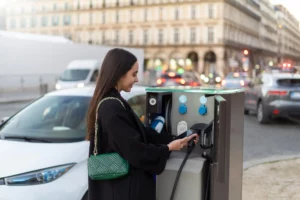
Home / EV Charging News / Can You Charge an Electric Car With a Generator or Backup Battery?
As electric vehicles (EVs) become more common, the question of how to charge them in various scenarios is gaining attention. While dedicated EV charging stations are ideal, what happens if you’re in a remote area or there’s a power outage? Can you charge an electric car using a generator or a backup battery? While both options are technically possible, they come with significant limitations and considerations. This article explores how generators and backup batteries work for EV charging, the practicality of each, and scenarios where these solutions might be necessary.
Before delving into whether a generator or backup battery can charge an EV, it’s important to understand the basic requirements of electric vehicle charging. EVs typically require a substantial amount of power to charge, and this power must be delivered at the correct voltage and amperage.
There are three main levels of EV charging:
Given the large amount of energy required for EV charging, the viability of using a generator or a backup battery depends on their ability to provide adequate power over a sufficient period of time.
In theory, using a generator to charge an electric car is possible, but there are several important factors to consider. Generators are typically powered by gasoline, diesel, or natural gas, which might seem counterintuitive for the eco-conscious EV owner, but in emergencies, this can be a necessary option.
Yes, but not all generators are up to the task. To charge an EV, the generator must supply enough power, ideally at 240V to match the needs of Level 2 charging, which is the minimum level of power required for practical charging times. Many home generators output at 120V, which is insufficient for EVs unless you are willing to wait an extremely long time.
Additionally, the generator’s wattage capacity must be high enough. For example, most home generators produce between 3,000 to 8,000 watts, while charging an EV at Level 2 requires at least 7,200 watts. A generator that outputs less than this will either charge the vehicle extremely slowly or not at all.
Larger inverter generators, capable of producing a steady and clean power output of at least 7,500 watts, are better suited for EV charging. These units can be expensive and cumbersome, but they are necessary to provide enough power for meaningful charging.
The main challenge of using a generator is the duration of charging. Even with a high-capacity generator, it will take a significant amount of time to provide enough charge to drive a meaningful distance. In most cases, the generator is more useful for providing a partial charge to reach the nearest dedicated charging station.
Additionally, generators are powered by fossil fuels, which might not align with the environmental goals of many EV owners. In an emergency, however, the benefits of being able to charge your car may outweigh these concerns.
Another potential solution is using a backup battery, often referred to as a power bank for electric vehicles. These batteries are typically portable units or part of a larger home energy storage system like the Tesla Powerwall or LG Chem RESU.
Yes, backup batteries can charge an EV, but their effectiveness depends on the battery’s capacity. Most portable power stations are designed to power small appliances during emergencies and may not hold enough energy to fully charge an EV. However, they can provide enough power to get the vehicle moving and reach a nearby charging station.
There are two main categories of backup batteries that could be used for EV charging:
A typical EV battery has a capacity of around 40 to 100 kWh, while a backup battery like the Tesla Powerwall can store about 13.5 kWh. This means a single Powerwall would only charge the EV by about 10-30%, depending on the vehicle’s battery size. This is enough to provide some extra range but not enough for a full charge.
Portable power stations, while convenient, usually lack the capacity to provide meaningful charging. They might give the vehicle enough energy for a few extra miles but would not be a long-term solution.
While charging an EV with a generator or backup battery is not ideal for everyday use, there are situations where these solutions may come in handy:
When using a generator or backup battery to charge an EV, safety is a key concern. Here are a few important tips:
While it is possible to charge an electric vehicle with a generator or backup battery, these methods are not without challenges. A generator can provide a temporary solution in emergencies, but it must have sufficient power output to be effective. Backup batteries can also offer partial charging solutions, especially larger systems like the Tesla Powerwall, but they are not designed for full vehicle charging.
For most EV owners, it’s best to rely on dedicated charging stations whenever possible. However, having access to a generator or backup battery can provide peace of mind in emergency situations or when traveling in areas with limited charging infrastructure. Proper planning and understanding the limitations of these charging methods can ensure you’re never left stranded with a low battery.
